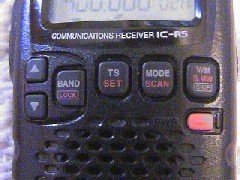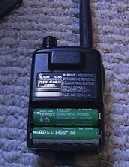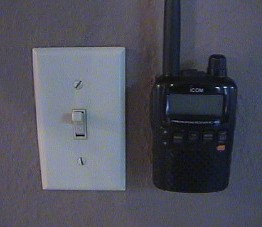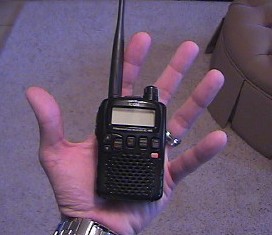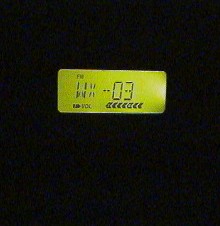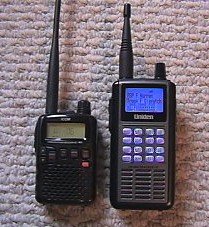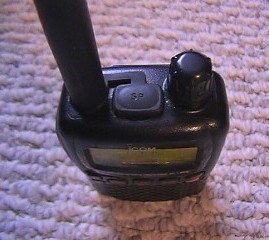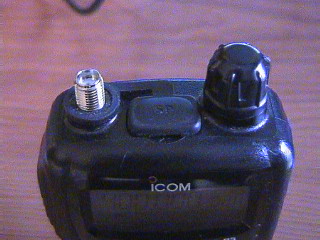Icom IC-R5 Review
written: 02/28/2007
The Icom IC-R5 has been out for several years now, but I have only recently gotten my hands on one. The Icom R5 is tiny by comparison to other "receivers." The lack of a full keypad turns some away from this little radio but don't let that keep you from owning a true performer!
Key Features
- Wideband Coverage 150 kHz to 1309.995 MHz (less cellular and gaps)
- 1250 Memories (1000 memories, 25 scan edge pairs, 200 auto write channels)
- 30 - 120 Minute Auto Power Off
- Built-in Ferrite Bar Antenna
- CTCSS/DCS Decode
- 6 Character Alpha Tags
- Priority Channel
- Weather Alert and/or Monitor
- Channel Alert Beep
- PC Programmable
- 2 AA Battery Operation
- Pocket Sized! 2.3 (w) x 3.4 (h) x 1.1 (d) inches
- Weighs only 6 oz.
In the Box
- Wall Charger
- Flexible SMA antenna
- 2 AA Rechargeable batteries
- Belt Clip
- Wrist Strap
- Owner's Manual
- Ham Radio Terms Booklet
- Hot 100 SWL List (short wave radio frequencies list that are preprogrammed into the R5)
Construction and Physical
The R5 is an attractive little receiver. Its gloss black outer shell gives an impression of quality. The R5 is built very sturdy. The outer case is plastic but has a very rugged feel to it, despite its small size. The R5 weighs only 6 oz. (185 kg). The control buttons have a good textile feel to them. They offer good feedback when pressing them. The VFO knob is large enough to be comfortable when turning and offers good feel with its detenting while turning. The antenna connection is SMA but you can purchase a SMA to BNC adapter if you have BNC antennas you prefer to use. The battery compartment is securely closed with a clasp type lock.
LCD. The LCD is easy to read and has a nice bright backlight! The alpha tags, although limited to 6 characters are large and easy to read, as are the signal strength meter, and other symbols displayed. When scanning banks, the display can either show you the frequency, memory name, bank name or channel number. You can change this as you wish but you can only display one at a time.The information displayed on the LCD varies depending on the mode you are using, but for the most part you will see: Frequency Readout, Key Lock Indicator, Receive Mode Indicator, Duplex Indicator, CTCSS or DCS Indicators, Skip Indicator, Priority Watch Indicator, Memory Indicator, Memory Channel #, Signal Strength Meter, Volume Meter (when volume is selected), Battery Meter, and Attenuator Indicator.
Speaker. The speaker is located under the control buttons. The speaker takes up approximately 1/3 of the face of the receiver. The audio is nice on such a small rig. Audio is much better on the R5 as compared to the Yaesu VR-120.
Performance and Features
The Icom IC-R5 is a very sensitive receiver. It shines in the VHF-High band (150 to 160 MHz). The R5 does suffer from interference from other sources, but can be easily overcome either by CTCSS/DCS or using the attenuator. The R5 does have a rather slow scan sped at only 10 channels per second or 30 steps per second when searching. Albeit this is not a scanner but a "Communications Receiver" as is plainly printed on the front of the IC-R5. You can use the R5 to search for CTCSS or DCS tones but you have to select one or the other and it is not instant. This can be somewhat evasive unless you hold on a channel and catch a lengthy transmission so that it has time to find the correct tone. The R5 has 3 receive modes, FM, WFM, and AM. Also has tuning steps of 5, 6.25, 8.33, 9, 10, 12.5, 15, 20, 25, 30, 50, and 100 kHz.
Weather Alert is a feature on the Icom R5 that works, and it works well. When turned "ON" the weather alert seeks the 1050 Hz tone from NOAA Weather Radio Repeater (that you preset) every 5 seconds, or so the manual says. I think it is more like 2 seconds. If you are listening to the scanner, you will hear a break in audio every couple seconds. I usually set the R5 on a frequency I know won't have traffic, and let the Weather Alert do its thing. I like the fact that this was added as a feature on the R5. (US Version Only)
HF Bands. This isn't the best receiver you can buy for shortwave listening and other HF DXing, however it does receive the stronger stations quite well at night. But don't expect great performance in this band.
AM Radio. Even with the built-in ferrite bar antenna, the AM reception stinks. You'd be better off going with a more dedicated AM radio if you were interested in that band. (A Kaito 1103 does well on AM and SWL).
VHF-Low Band. I don't have much in this band to monitor in my area. I have monitored some local VHF-low signals in the 37.000 range with good results. But no long distance monitoring.
VHF-High Band. This is where the Icom IC-R5 shines. It pulls in VHF High signals like nobody's business. I am extremely impressed with the receive capability in this range. I can consistently monitor VHF-High frequencies from 30 to 50 miles on a daily basis with ease. Now keep in mind I am not using the stock antenna. I use an extendable antenna that came off of a Pro-2055 scanner, but even with the stock antenna the little receiver does extremely well. But adding a band specific antenna really shows the receivers strength!
UHF Band. Again, very little UHF traffic in my area. I only have about 2 frequencies that are of interest to me in this area and I have not had an opportunity to test them on this receiver, sorry.
800 MHz Band. The R5 is decent on 800 MHz. I can pull in signals from 40 miles using 800 MHz band specific antenna however I cannot do this consistently. Usually late in the evening, is when these signals roll in. Almost everything within reasonable distance to me is P25 digital so I can only hear the data.
Civilian and Military Air. Again, the R5 is a good air band receiver and is why many people buy this receiver. It has the 8.33 step size that many air band enthusiast want in a receiver. It is very sensitive in the Civ Air band but also seems to be plagued with interference in this band range, at least in my area. MilAir is a little more tricky as I have only had the chance to catch a couple of active frequencies but seems to do well in this range, but is also plagued with interference.
Audio. Audio on the R5 is surprisingly loud for such a small receiver. It is loud enough for most mobile use situations. For indoor, it is more than powerful enough. It has crisp clean audio that does not distort at higher levels. I like the fact that the audio control is on the face, the up and down buttons control the volume. This can be easily changed for those who prefer the VFO knob to control volume levels.
Memory. The R5 has 1200 programmable memory channels. These store alphanumeric memories, frequency, mode, step size, duplex direction and offset, CTCSS or DCS and skip settings. The attenuator is global and is not applied per channel, which is a small disappointment, but nothing major. You can copy a memory channels contents to VFO or another memory channel which is handy for manual programming. You can have 1 priority channel as well and can "watch" it while memory is scanning, or VFO scanning.
Battery Consumption. I use Energizer 2500 mAh rechargeable batteries. They last approximately 10 to 12 hours while scanning with the LCD back light on 100% of the time. Truly a power sipping receiver! Great battery life! The battery life can be extended further by turning the back light off or to Auto (only comes on when pressing buttons).
Squelch. Squelch on the R5 is different in that it is digitally represented on the screen. You can set it to Open, Auto, or Level 1 - 9. I find that Auto works great on most everything. I use he Open mode when using it for AM or Shortwave Listening.
Dislikes. The Icom R5 is very difficult to use and understand the functions. If not for the programming software, I think I would have given up. The controls and programming steps are awkward to say the least. To be a great receiver, I almost was put off by the complexity of the operation of the receiver (and I am no rookie). This is not for the novice or weak of heart. If you do buy, do yourself the favor and get the programming software and programming cable. You will thank me! Don't expect the Owner's Manual to shed much light on the confusing interface. The OM is poorly written and is very hard to understand.
The R5 only allows bank scanning by 1 or all. Meaning you cannot link banks together and scan them. You can either scan 1 bank, or you can scan all banks. This is annoying at times, but can also be overcome by adding duplicate channels to banks. When programming, you have to add a frequency to the master list, and then assign it to a bank. So if you want 2 of the same frequencies in different banks, you have to add it twice to the master list and assign them to different banks. Just a minor annoyance.
The interference is annoying, but as stated earlier, if you use the Attenuator function and/or CTCSS/DCS feature, it cures that problem.
The lack of a full keypad is missed but does't really bother me that much. The missing keypad helps keep it's small footprint!
Missing chunks of the 800 MHz Band are another gripe from many users. The frequency ranges covered by the Icom R5 are from 0.15 to 823.995 MHz. 849.00 to 868.995 MHz. And 894.000 MHz to 1309.995 MHz. So anything above 868.995 up to 894.000 is missing (US version only). Some public safety agencies operate in parts of that range and may be a problem for some. Fortunately it was not a problem in my area.
I would have liked to have seen NFM mode and the 7.5 step size for Narrowband. It wasn't a deal breaker as most frequencies round up or down easily with no problems.
Some complain about the belt clip being flimsy but I purchased my R5 used and did not receive a belt clip.
Conclusion
The Icom IC-R5 is a great receiver. It far surpasses any handheld that I have used on VHF-High band. The little receiver has some drawbacks, however they aren't enough that you shouldn't enjoy the features and performance it has to offer. Universal Radio has them and numerous accessories at great prices. I got my Icom R5 used at a great deal that included software and programming cables. If you find a good deal, don't pass it up. If you need a "communications receiver" then I recommend the Icom IC-R5. If, on the other hand, you need a "scanner' then look elsewhere, because the R5 is not a "scanner." Obviously there are other features on the Icom R5 that aren't covered in this review. You can view a full list of specifications and features on the Icom America website.
If you are comparing the VR120 to the Icom R5, then you will have a tough decision to make. There are features on each that are appealing. The VR120 has an easier to use interface in my opinion. The audio on the R5 is much better. Both have near equal receive sensitivity. The VR120 has some very useful features like "One Touch Memory" where you can assign a frequency to a button on the receiver for quick access. Also the "Dual Watch" and "Preferential Memory Scan" are great features on the VR120 as well. If the Icom had those few features it would be near perfect! But the VR120 lacks the audio and CTCSS/DCS and a few other features to make it useful in day to day monitoring of multiple frequencies for me.
Performance, size, and features are enough to warrant the $150 to $200 price tag on the R5. A good solid receiver that is a true performer.
